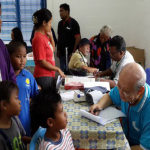We have entered the COVID-19 endemic phase in Malaysia. This does not mean that the fight is over but it does mean that we have to learn to live with the virus and accept that many of us will likely contract it. With vaccination, the symptoms are milder now and the rate of deaths have decreased, the virus still affects many in more subtle ways. Prof James Koh Kwee Choy (in the photo above), Consultant Infectious Diseases Specialist and Professor of Medicine in IMU, and Shen Choo, a personal trainer, shed some light on long COVID and fitness levels post-infection. As we accept life with COVID-19, it is a must that we continue to understand it better. Knowledge of how the virus affects us—not just during infection but after—keeps evolving as doctors document the experiences of people, and as scientists and researchers work hard to interpret what they see in laboratories across the world. At the most basic level, the SARS-CoV2 – the virus responsible for COVID-19 – primarily targets the respiratory system of an infected person. “We also know now that the effect of the disease is not confined to the respiratory system but can extend to other systems including the cardiovascular, dermatological, musculoskeletal and neurological systems,” says Prof James. He goes on to explain that although most people recover from COVID-19 relatively unscathed, some do experience prolonged effects of the infection including symptoms associated with long COVID syndrome and chronic fatigue syndrome. According to Prof James, a person is said to have long COVID if symptoms persist beyond twelve weeks after recovery from a COVID-19 infection. People experience a wide range of conditions from fatigue, persistent shortness of breath, chest pain or tightness, problems focusing, and other symptoms. Many of these symptoms are subjective and not easily detectable by routine investigations. “Although the symptoms are well established, we do not know a lot about long COVID. So far, we have not been able to identify reliable investigation markers that can help to diagnose it,” Prof James says. This means that even if you have the symptoms, medical examinations such as EKGs and ultrasounds, may not detect any abnormalities. Long COVID – who does it affect? “Generally, people who are unfit to begin with or have cardiovascular or respiratory diseases are more prone to significant compromise of their fitness levels. However, even relatively fit people with mild or asymptomatic COVID-19 have been reported to experience significant deterioration of their fitness levels post-COVID-19,” says Prof James. Many factors affect each individual’s experience of long COVID. He adds, “We do know that COVID-19 causes hyper-inflammatory responses in the body, especially in severe categories of the infection. How these responses affect or influence the recovery of affected organs in the body is still largely unknown. Some patients recover completely while others seem to have residual effects weeks and months down the road.” The time taken to fully recover is dependent on many factors including the presence of other illnesses before COVID-19. The fitness level of a person may also determine how quickly a person recovers from COVID-19. “Exercise is known to boost immunity; therefore, a fit person tends to recover faster from COVID-19 compared to an unfit person. It is important to maintain an optimum level of physical health and avoid habits that are detrimental to health and fitness such as smoking, excessive alcohol consumption, high stress level, lack of sleep, sedentary lifestyle and poor diet,” Prof James advises.
| A personal experience |
|---|
| However, it does not mean that even if you are very fit that you will get away scot-free post-COVID. Personal trainer and marathon runner, Shen Choo, shares her own experience with COVID-19. Having contracted COVID-19 in March 2022, she found it frustrating as her energy levels fluctuated. With much determination, she managed to still conduct her online training classes with her clients every day, except for one day. However, after she had recovered from the infection (about a week after first testing positive) she noticed a shift in her fitness levels. Being a marathon runner, she is used to running more than 10km stretches, but post-COVID, she says: “I couldn’t last more than 3km. Some of my other runner friends were the same. Some felt out of breath. For me my form was off because of joint pains and that led to a knee injury which I am still nursing till today,” she says. “I have had yoga mates who had COVID-19 and they all complain of joint pains and whatever positions that we used to be able to do, we just cannot get into it for one reason or the other,” she adds. Even for Shen, it has taken about two months for her to feel that her body is getting back to normal. |
Starting to exercise Exercise is definitely one way to recover one’s fitness level. However, there are important issues to consider before one jumps in and starts exercising after COVID-19. “Generally, exercise is not recommended if the person still has symptoms. A person with pre-existing heart or lung problems should consult his doctor before restarting exercise. Myocarditis is a known complication in post-COVID-19 patients which can be fatal. Chest pain, palpitations and shortness of breath are symptoms of myocarditis. The important thing is to listen to your body,” says Prof James. Prof James also says: “Some guidelines recommend an incremental exercise load stretched over weeks to slowly regain one’s fitness level. This should, ideally, be done under supervision of a trained personnel or monitored by a doctor.” Shen’s recommendation for those who are starting out on a fitness journey is to start slow and keep a journal of how you feel after each exercise. This will help you to determine what works for you and how your body is responding. “A diary will help you to be mindful of any adverse effects as well,” she says. Start with gentle exercises such as yoga stretches, says Shen. “It’s something you can do even if down with COVID-19. It helps with circulation and will make you feel better.” These include simple movements such as arm twists and hugging your knees to the chest. “I felt that every time I moved a little bit when I was down with COVID-19, I felt a little better. There is a lot of joint soreness so when you mobilise yourself, you get the circulation going. Endorphins will also kick in, and this helps to take away some of the pain,” she adds.
| Returning to a more demanding regime |
|---|
| For those who have always had a demanding exercise regime, she suggests investing in a monitoring device, such as a smartwatch, that can monitor your heart rate before getting back into a routine post-COVID. “You may have always had underlying issues which you did not realise but which surface because of long COVID,” she says, citing a fellow marathon runner who many months after recovering from COVID still wheezes when she climbs a flight of stairs. Keeping an eye on vital signs will help you avoid overexertion or other more serious outcomes. Shen also especially appeals to athletes to be mindful of pushing too far: “As athletes we find it hard to embrace the fact that we’re not well. The mindset is that it is all a matter of training, and that when the mind is strong, you will get there somehow. But with COVID-19, one should not underestimate the after effects on the body. It may seem like it’s nothing but actually it is more deep set than one would like to admit. “We need to acknowledge that sometimes, although the mind is strong, physically we may still be weak. Remember that rest and recovery is an important part of any training regime.” |
It’s individual One thing for sure is that everyone experiences a slightly different path. As Prof James says: “The road to full recovery of fitness levels post-COVID-19 is very individualised. It depends on pre-existing fitness levels and presence of other co-morbidities such as diabetes mellitus, high blood pressure, high cholesterol, obesity, and habits such as smoking and excessive alcohol consumption. A person with few or no risk factors tends to regain their fitness level faster.”
“However, some patients never really recover their pre-COVID-19 fitness level although this may be possible given more time. Any improvement of fitness level post-COVID-19 is beneficial.”
Shen also reminds us that we should not succumb to peer pressure. She explains that sometimes we push ourselves to keep up with others because we just don’t want to be left behind. But this can be dangerous. Her advice: listen to your own body and slow down if you can’t keep up. So take it slow, listen to your body and remember it is not a competition with others. It’s important that each of us finds our own paths (whether it is to walk, run or just to stretch) to recovery.









